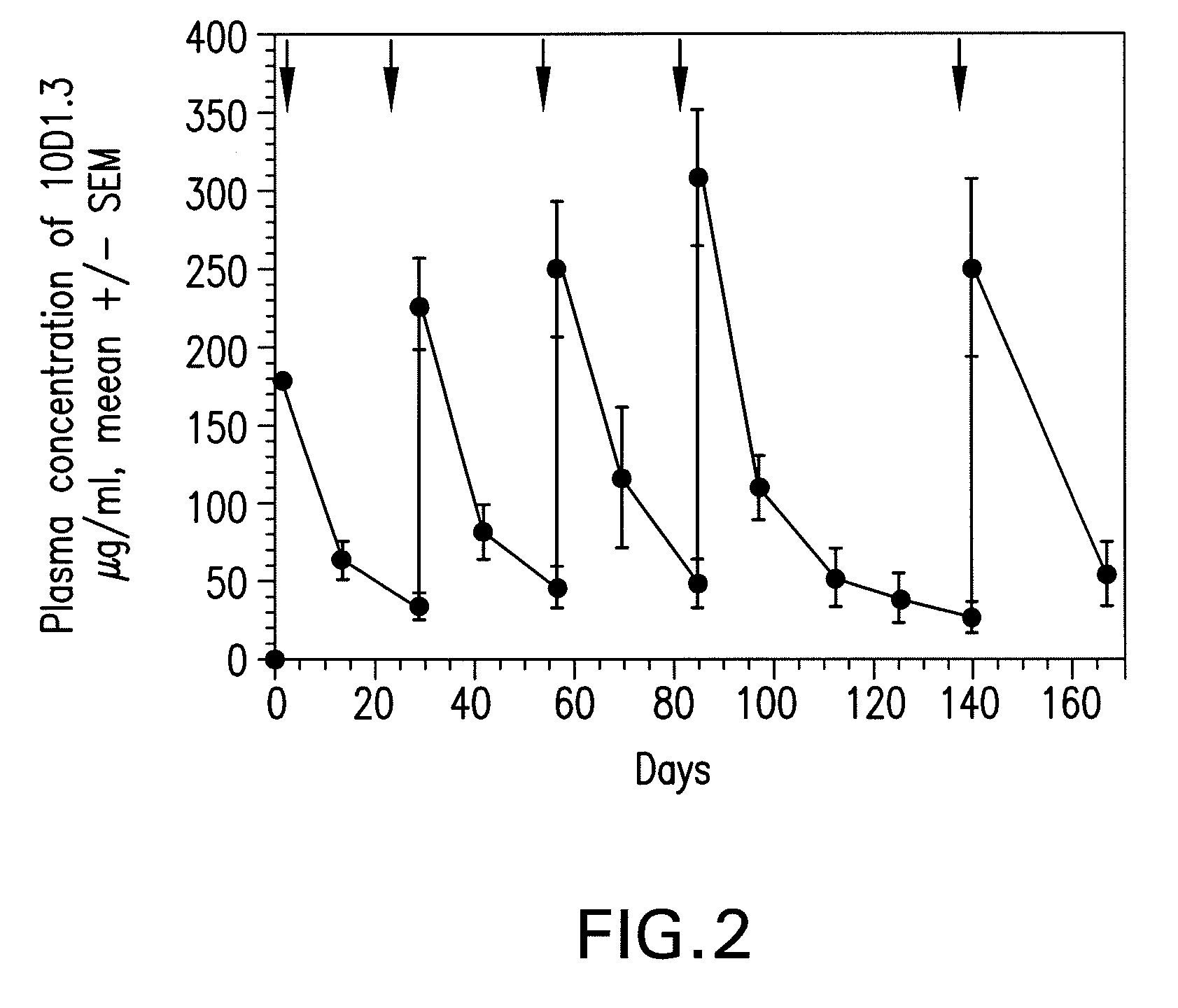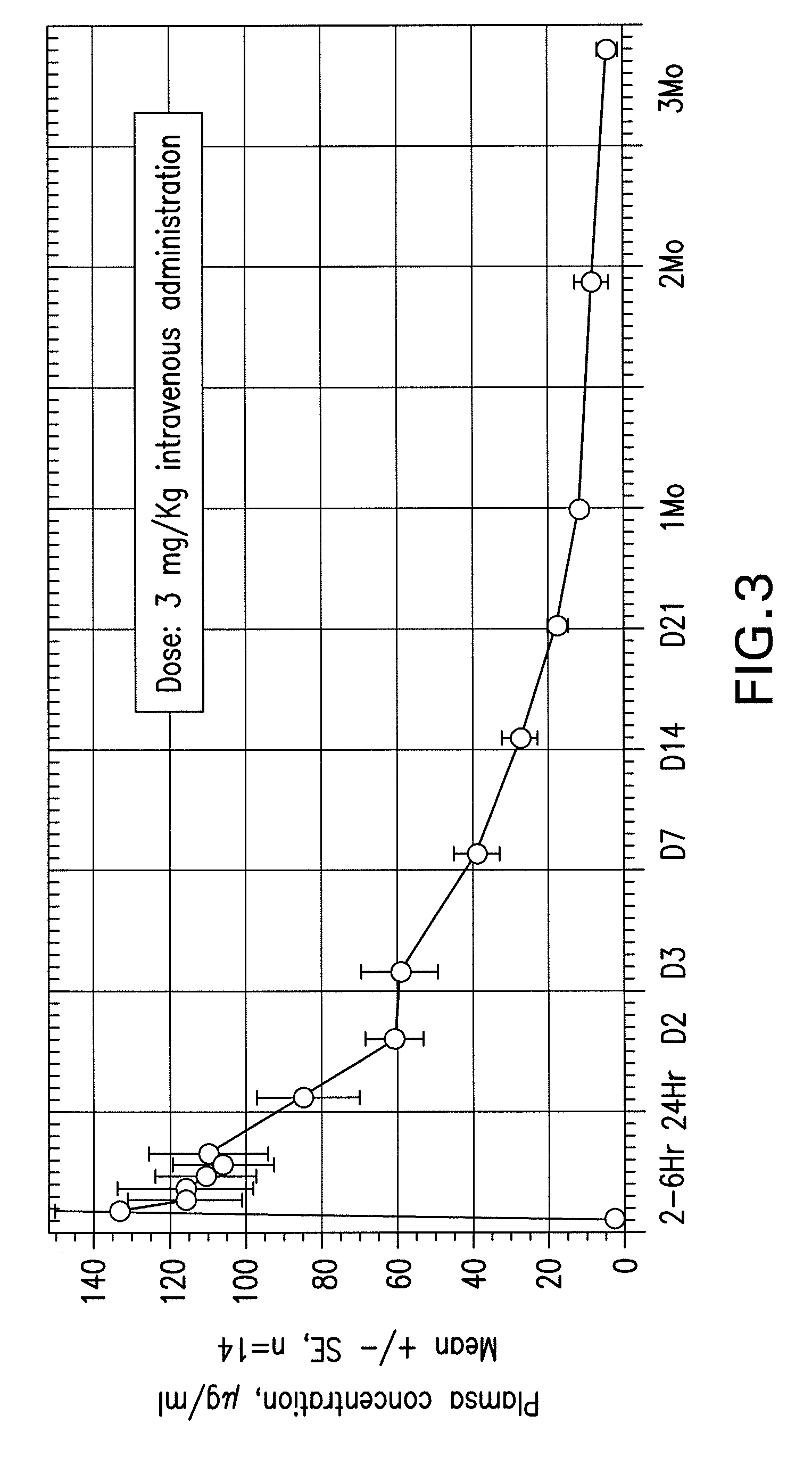Methods Of Treatment Using CTLA-4 Antibodies
a technology of ctla-4 and antibody, applied in the field of molecular immunology and the treatment of human diseases, can solve problems such as clonal inactivation or anergy, and achieve the effect of enhancing the immune response to an antigen
- Summary
- Abstract
- Description
- Claims
- Application Information
AI Technical Summary
Benefits of technology
Problems solved by technology
Method used
Image
Examples
example 1
Anti-CTLA-4 Treatment Enhances Secondary Antibody and T Cell Responses to a Melanoma Cell Vaccine in Cynomolgus Monkeys
[0092]The ability of a human anti-CTLA-4 antibody of the invention to enhance antibody and T cell responses to a melanoma cell vaccine was examined in cynomolgus monkeys (obtained from Primate Products, Miami, Fla.). Test groups of six monkeys each (three males, three females) were treated with either 1) a melanoma cell vaccine alone (SK-mel-3, a human melanoma tumor cell line transfected to express GM-CSF) or 2) both SK-mel-3 and the anti-CTLA-4 antibody 10D1 described in WO 01 / 14424. A whole cell vaccine would allow for investigation of autoimmune reactions to a variety of normal tissues in this animal model, despite the fact that the cellular vaccine was of human origin.
[0093]To prepare the vaccine, SK-mel cells were grown to confluency and harvested. The cells were treated with mitomycin C, washed several times and resuspended to 1×107 / ml saline. The antibody wa...
example 2
Evidence of Antigen-Specific T Cell Proliferation from Delayed Type Hypersensitivity (DTH) Experiments in Humans
[0096]Nineteen patients with resected Stage III (2 patients) or IV (17 patients) melanoma received escalating doses (0.3, 1 and 3 mg / kg) of CTLA-4 antibody 10D1 with each injection of gp100 / tyrosinase / MART-1 peptide vaccine with incomplete Freund's adjuvant. The tyrosinase 368-376 (370D), MART-126-35 (27L) and gp100:209-217 (210M) peptides each differed from wild type by one amino acid modification to increase HLA binding. The vaccine was administered eight times over twelve months at 1 mg / dose / peptide. Immune responses measured by DTH reactivity indicated that four of nine patients responded to gp100 and two of nine patients responded to MART-I. ELISPOT assays showed immune responses in four of sixteen patients tested using fresh CD8 T cells.
example 3
Results from Phase I Human Clinical Trials of MAb 10D1 Melanoma (MDXCTLA4-02)
[0097]MDXCTLA4-02 was a Phase I open-label, multicenter clinical trial to evaluate the safety and pharmacokinetics of MAb 10D1 in seventeen patients with progressive, unresectable, malignant melanoma. Median age was 59 years (range 29-79). Nine patients had received prior immunotherapy, six had prior radiation and five had prior chemotherapy. All patients received a single dose of 3 mg / kg of 10D1 intravenously over 90 minutes and were then followed for toxicity, pharmacokinetics, circulating T cell activation and clinical outcome. All infusions were completed with only mild adverse events. Seven patients had mild, reversible rashes or pruritis. Plasma levels of antibody persisted from one to four months. There was no significant increase in activated peripheral T cells and no evidence of clinical autoimmunity beyond the mild rash. Two patients experienced a partial response including resolution of three sof...
PUM
| Property | Measurement | Unit |
|---|---|---|
| concentration | aaaaa | aaaaa |
| concentration | aaaaa | aaaaa |
| concentration | aaaaa | aaaaa |
Abstract
Description
Claims
Application Information
 Login to View More
Login to View More - R&D
- Intellectual Property
- Life Sciences
- Materials
- Tech Scout
- Unparalleled Data Quality
- Higher Quality Content
- 60% Fewer Hallucinations
Browse by: Latest US Patents, China's latest patents, Technical Efficacy Thesaurus, Application Domain, Technology Topic, Popular Technical Reports.
© 2025 PatSnap. All rights reserved.Legal|Privacy policy|Modern Slavery Act Transparency Statement|Sitemap|About US| Contact US: help@patsnap.com



